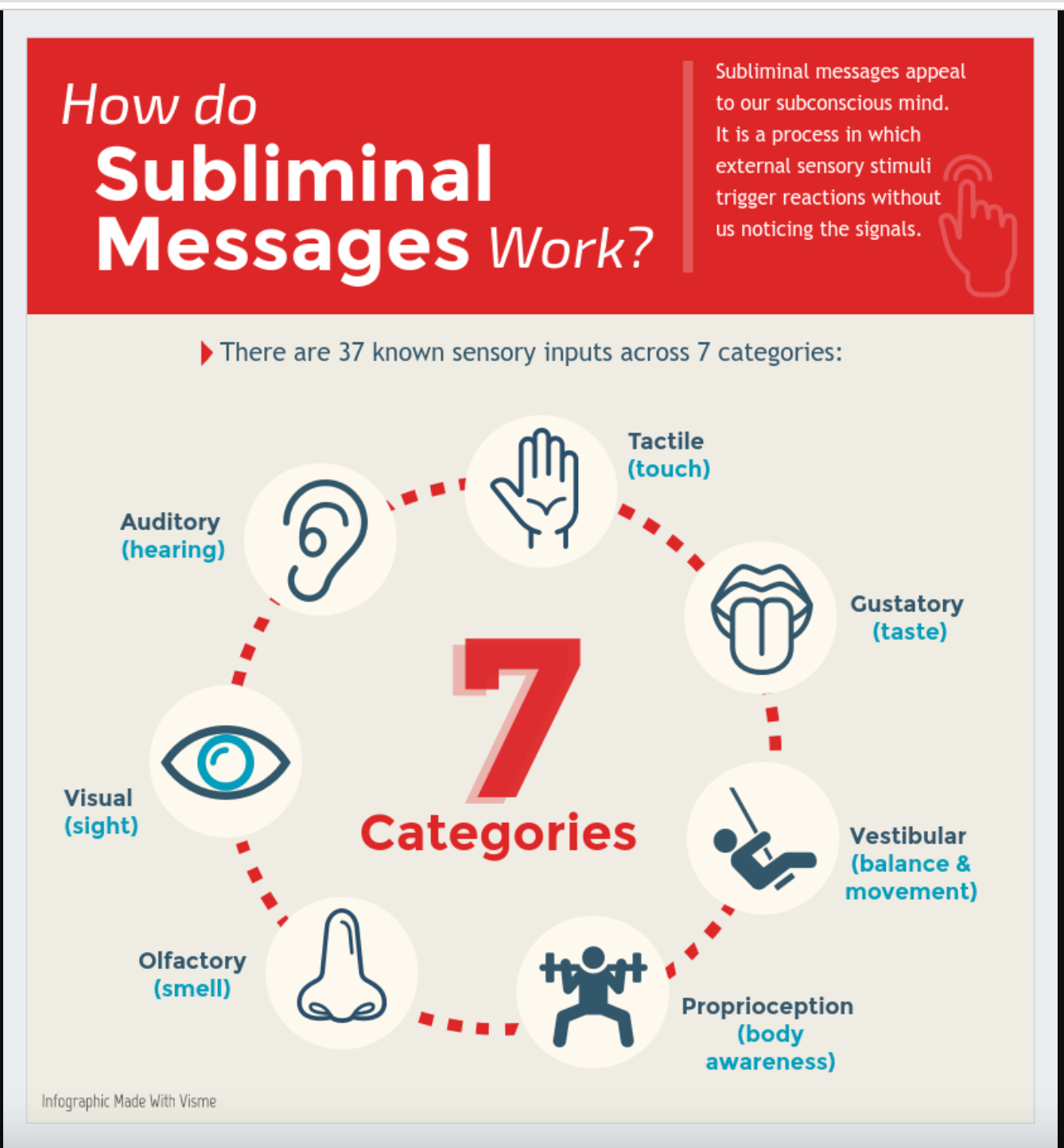Your cart is currently empty!

Cultural Subversion
The influence of media, advertising, and music on public opinion and consumer behavior runs deeper than ever. Beneath the surface of our catchy jingles, visually appealing commercials, and captivating movies lies a sophisticated mechanism of cultural manipulation driven by corporate institutional influences. These mechanisms are informed by decades of research into experimental psychology and are strategically used to manipulate the public, shape their perceptions, desires, and even political inclinations. Our Financial elites use the institutional leverage at their disposal to exploit popular culture and manufacture consent through subliminal messaging and other psychological techniques.
The Historical Context of Subliminal Messaging
Subliminal messaging has been a topic of interest and controversy since the 1950s when James Vicary claimed to have increased popcorn and Coca-Cola sales by flashing messages during a movie. Although his experiment was later debunked, it opened the door to exploring how hidden messages could influence consumer behavior. Vance Packard’s book “The Hidden Persuaders” further exposed the manipulative tactics used by advertisers, setting the stage for a deeper understanding of how psychological techniques could be used for mass influence.
The Psychological Foundations
Sigmund Freud’s theories on the unconscious mind laid the groundwork for understanding how hidden drives and emotions influence behavior. His nephew, Edward Bernays, applied these theories to public relations and advertising, believing it was the duty of marketing professionals to manipulate public opinion for the greater good. In his book “Propaganda,” Bernays argued that the masses are irrational and need to be guided by an elite class that understands their true desires and fears.
Modern neuroscience has confirmed that subliminal messages can indeed activate certain areas of the brain and influence behavior without conscious awareness. Techniques such as galvanic skin response and pupil dilation measurement are used to gauge unconscious reactions, illustrating how deeply ingrained and powerful these subliminal cues can be.
Media and Advertising: Tools of Manipulation
Advertising has evolved into a sophisticated tool for influencing public opinion and consumer behavior. Advertisers use a variety of techniques to create unconscious associations with products, often exploiting sex and death imagery to evoke strong emotional responses. For example, Marlboro ads have been found to contain hidden phallic symbols, which subconsciously enhance the viewer’s attraction to the brand.
The public’s awareness of subliminal advertising grew significantly in the 1950s, leading to Congressional hearings and public outcry. Despite the backlash, the advertising industry continued to refine its techniques, embedding subliminal messages in commercials, movies, and music. Modern examples include product placements in movies and TV shows, where brands are subtly integrated into the storyline, creating an unconscious desire for the product.
Case Studies and Controversies
The trial involving the band Judas Priest is a notable example of how subliminal messages in music have been alleged to influence behavior. In the 1980s, the band was accused of embedding the phrase “do it” in their song “Better by You, Better than Me,” which was claimed to have driven two young men to commit suicide. Although the band was acquitted, the case highlighted the potential dangers of subliminal messaging.
Similarly, Alfred Hitchcock’s use of subliminal techniques in films like “Spellbound” and “Psycho” demonstrated how subtle visual cues could enhance emotional impact. These techniques are now standard practice in Hollywood, where filmmakers use a combination of visual and auditory subliminals to manipulate audience reactions.
The Role of Financial Elites
Financial elites have long understood the power of media and advertising to shape public opinion. By funding popular culture, they can subtly influence the masses to accept certain political and economic agendas. This concept, known as the “manufacture of consent,” was popularized by Noam Chomsky and Edward S. Herman in their book “Manufacturing Consent.”
Through ownership and control of major media corporations, financial elites can ensure that their interests are represented and promoted. The consolidation of media ownership means that a small number of corporations control the vast majority of information consumed by the public. This centralization of power allows elites to craft narratives that serve their interests while marginalizing dissenting voices.
Celebrities as Modern-Day Idols
In modern society, celebrities have taken on a role similar to that of Greek gods, becoming idols that many people look up to and emulate. This idolization gives financial elites another powerful tool to manipulate public opinion and behavior. By deciding which personalities to fund and promote, they can create celebrities who embody certain values and lifestyles that align with their interests.
Celebrities are not only influential through their work in music, film, and television but also through their off-stage and off-camera behavior and opinions. Media outlets, controlled by financial elites, have the power to either demonize or reward celebrities based on their actions and statements. This selective portrayal can elevate certain individuals to heroic status while vilifying others, thereby controlling the “idols” society looks to for guidance.
For example, a celebrity who promotes consumerism and materialism may receive extensive media coverage and positive reinforcement, encouraging their fan base to adopt similar values. Conversely, a celebrity who speaks out against corporate interests or promotes alternative lifestyles may be subjected to negative media campaigns, diminishing their influence and credibility.
This manipulation extends to the political arena as well. Celebrities who endorse specific candidates or policies can sway public opinion and mobilize voters. Financial elites leverage this by backing celebrities who support their political agendas, using their influence to reinforce messages introduced elsewhere in the cultural zeitgeist.
By controlling the celebrities that society idolizes, financial elites can further entrench their influence over public opinion and behavior, creating a feedback loop that reinforces their control over popular culture.
The Impact on Society
The pervasive influence of subliminal messaging and media manipulation has significant implications for society. Advertising works best on individuals who are lonely or afraid, creating a cycle of dependency on products to fill emotional voids. This has contributed to widespread issues such as consumerism, body image disorders, and mental health problems.
Moreover, the use of subliminal messaging in political campaigns can sway public opinion and electoral outcomes. For instance, during the 2000 U.S. presidential campaign, a Republican ad briefly flashed the word “RATS” to associate Al Gore with negative connotations. Such tactics undermine the democratic process, manipulating voters rather than informing them.
Conclusion: The Need for Awareness and Critical Thinking
In a world where media and technology are omnipresent, it is crucial to develop awareness and critical thinking skills. Understanding the psychological mechanisms behind advertising and media can help individuals recognize when they are being manipulated. Educational resources and documentaries like “The Century of the Self” by Adam Curtis and books like “Subliminal: How Your Unconscious Mind Rules Your Behavior” by Leonard Mlodinow can provide valuable insights into these practices.
Ultimately, the fight against cultural subversion by financial elites requires a collective effort to demand transparency, accountability, and diversity in media. By fostering a more informed and critical populace, society can resist the manipulative tactics used to manufacture consent and uphold the principles of democracy and individual freedom.
Recommended Resources for Further Reading
- Books:
- “The Hidden Persuaders” by Vance Packard
- “Subliminal: How Your Unconscious Mind Rules Your Behavior” by Leonard Mlodinow
- “Propaganda” by Edward Bernays
- “The Age of Propaganda: The Everyday Use and Abuse of Persuasion” by Anthony Pratkanis and Elliot Aronson
- Academic Papers and Articles:
- “The Psychology of Advertising” by Bob M. Fennis and Wolfgang Stroebe
- “Subliminal Advertising: What You See Is What You Get” by Andrew J. Greenwald, Anthony R. Pratkanis, and others
- “The Impact of Subliminal Stimuli on Consumer Behavior” by Charan K. Bagchi and Amar Cheema
- “The Shocking Drink And Incredible Coke History Of Subliminal Advertising” by Dylan Love
- Documentaries and Videos:
- “The Century of the Self” by Adam Curtis
- “Consuming Kids: The Commercialization of Childhood” by Adriana Barbaro and Jeremy Earp
- “The Merchants of Cool” by Barak Goodman

Leave a Reply